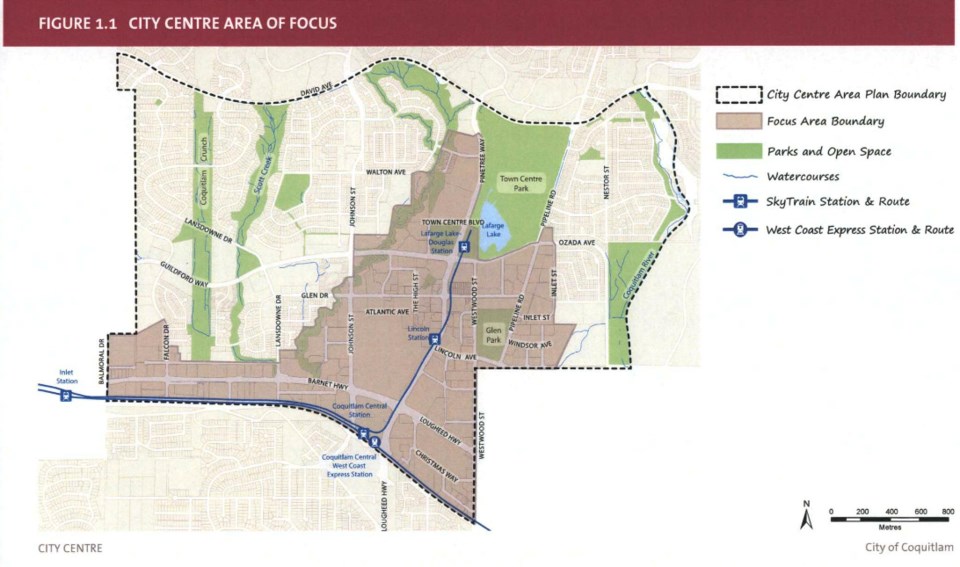Coquitlam has sketched out an early game plan to attract office space to city centre.
But whether it’s a winning formula won’t be known for decades.
City staff presented a report to council Monday outlining strategies to create a downtown and double employment in the area in 25 years.
The report noted, Coquitlam’s city centre encompasses 1,789 acres — and Vancouver’s is 1,157 acres.
“Our downtown is physically the same size as Vancouver, which is from Stanley Park to Chinatown, which is a huge area with lots of stuff in it. We can’t achieve [what Vancouver has] overnight,” manager of community planning Andrew Merrill pointed out to council.
The staff report said, “It is important that the existing malls and shopping plazas do not become solely residential enclaves. Commercial and office development is essential for securing long-term economic prosperity since it adds to the non residential tax base and provides job opportunities.”
The city envisions office business districts built around the Lincoln and Coquitlam Centre SkyTrain stations. The report notes the closer office buildings are to SkyTrain stations, the lower the vacancy rates and the higher the rents.
The city is proposing developers be required to build standalone office buildings, although in combination with other types of development since the districts are not meant to become exclusively office precincts.
In 2011, with 10,500 jobs in the City Centre, Coquitlam set the bar for growth at 22,000 by 2041. By 2016, however, the first five years yielded fewer than 500 jobs. Now, the city is looking at doubling the number of jobs in the area if it’s to reach its 2041 goal.
To help make it happen, the planning department proposed to double the current minimum commercial density requirement for developers to create a complete downtown.
Coun. Brent Asmundson suggested tripling it but Merrill said given that the market is cool on Coquitlam office space, preferring to be closer to Vancouver, “tripling it as opposed to doubling it seemed a little bit too far.”
Coun. Dennis Marsden said it’s critical for Coquitlam to see more people get off at its SkyTrain stations to go to work and get on to go home — currently, the reverse scenario dominates. Marsden also encouraged staff to find out what big companies would need to come to the area, like Surrey has done with its city centre in the Whalley neighbourhood.
“What we have to do is make it abundantly clear to everyone we want to move this beyond local employment service to something much bigger than that,” said Marsden.
Coun. Bonita Zarrillo wasn’t as enthusiastic, noting, for instance, that seniors make up a large portion of the downtown core and need health services.
“I don’t know how that is going to fit in with these commercial zones,” she said. “I’m very scared to say, 'Yeah this is the way it should look' because I think we need to build to the future and I don’t know what it looks like.”
In conjunction with the office space, the report proposes an entertainment district — restaurants, pubs, lounges, nightclubs, movie theatres, live entertainment venues — along a southern extension of The High Street through the current Coquitlam Centre mall site connecting the two business office districts.
The city would also like to see a hotel near Lougheed Highway and Pinetree Way to anchor the two business districts, although the report didn’t dismiss exploring other locations. It also suggested a combination hotel and residential tower could be considered. Surrey’s city centre and Burnaby’s Metrotown areas each has a hotel/condo combo. The report said the hospitality industry believes Coquitlam could support an additional hotel, particularly in City Centre.
The report also proposes zoning other areas of the area for a mix of commercial and light industrial but no residential. Those would located in the southeast corner of city centre south of Christmas Way and along Barnet Highway toward Port Moody.
Along with council’s feedback, staff will seek input from the city’s economic development advisory committee, the development community and affected land owners before refining the strategy.



